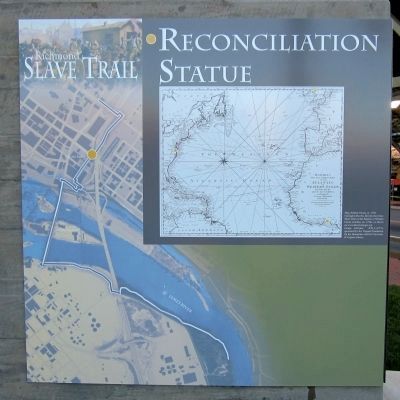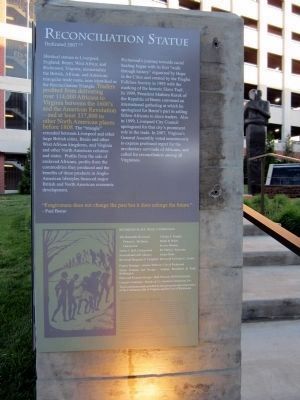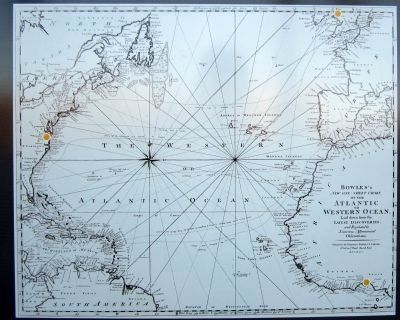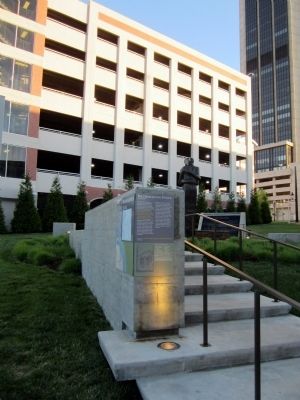Shockoe Slip in Richmond, Virginia — The American South (Mid-Atlantic)
Reconciliation Statue
— Richmond Slave Trail —
Identical statues in Liverpool, England; Benin, West Africa; and Richmond, Virginia, memorialize the British, African, and American triangular trade route, now identified as the Reconciliation Triangle. Traders profited from delivering over 114,000 Africans to Virginia between the 1600’s and the American Revolution – and at least 337,800 to other North American places before 1808. The “triangle” extended between Liverpool and other large British cities, Benin and other West African kingdoms, and Virginia and other North American colonies and states. Profits from the sale of enslaved Africans, profits from the commodities they produced and the benefits of these products in Anglo-American lifestyles financed major British and North American economic development.
Richmond’s journey towards racial healing began with its first “walk through history” organized by the Elegba Folklore Society in 1993 with the marking of the historic Slave Trail. In 1999, President Mathieu Kerek of the republic of Benin convened an international gathering at which he apologized for Benin’s part in selling fellow Africans to slave traders. Also in 1999, Liverpool City Council apologized for that city’s prominent role in the trade. In 2007, Virginia’s General Assembly voted unanimously to express profound regret for the involuntary servitude of Africans, and called for reconciliation among all Virginians.
“Forgiveness does not change the past but it does enlarge the future.” - Paul Boese
Richmond Slave Trail Commission
The Honorable Reverend Delores L. McQuinn, Chairperson • Janine Y. Bell, Chairperson • Nessa Baskerville • Johnson • Reverend Benjamin P. Campbell • Charles S. Vaughan • Ralph R. White • Kennis Wooten • Dr. Philp J. Schwartz • Jennie Dotts • Reverend Sylvester L. Turner • Project Manager – Jeannie Welliver, City of Richmond • Statue Sculptor and Design – Stephen Broadbent & Faith Bebbington • Plaza and Fountain Design – Burt Pinnock, BAM Architects • General Contractor – Brooks & Co. General Contractors, Inc.
This installation made possible by the generosity and cooperation of the Commonwealth of Virginia and the City of Richmond.
About the Trail
Designed as a walking path, the Richmond Slave Trail chronicles the history of the trade in enslaved Africans from their homeland to Virginia until 1778, and away from Virginia, especially Richmond, to other locations in the Americas until 1865. The trail begins at the Manchester Docks, which, alongside Rocketts Landing on the north side of the river, operated as a major port in the massive downriver slave trade, making Richmond the largest source of enslaved blacks on the east coast of America from 1830 to 1860. While many of the slaves were shipped on to New Orleans and to other Deep South ports, the trail follows the footsteps of those who remained here and crossed the James River, often chained together in a coffle. Once reaching the northern riverbank, the trail then follows a route through the slave markets and auction houses of Richmond, beside the Reconciliation Statue commemorating the international triangular slave trade and on to the site of the notorious Lumpkin’s Slave Jail and leading on to Richmond’s African Burial Ground, once called the Burial Ground for Negroes, and the First African Baptist Church, a center of African American life in pre-Civil War Richmond. - Richmond Slave Trail Commission – 2011 –
Title image: “After the Sale: Slaves Going South”, 1853, Painted from live by Eyre Crowe, courtesy the Chicago History Museum
Erected 2011 by Richmond Slave Trail Commission. (Marker Number 13.)
Topics. This historical marker is listed in these topic lists: Abolition & Underground RR • African Americans • Peace. A significant historical year for this entry is 2007.
Location. 37° 32.085′ N, 77° 25.825′ W. Marker is in Richmond, Virginia. It is in Shockoe Slip. Marker is at the intersection of East Main Street
(U.S. 60) and North 15th Street, on the left when traveling east on East Main Street. Touch for map. Marker is in this post office area: Richmond VA 23219, United States of America. Touch for directions.
Other nearby markers. At least 8 other markers are within walking distance of this marker. The Triangle (a few steps from this marker); Odd Fellows Hall (within shouting distance of this marker); Slave Auction Site (within shouting distance of this marker); Bell Tavern (within shouting distance of this marker); Davenport Trading Company (about 500 feet away, measured in a direct line); Auction Houses (about 500 feet away); Kahal Kadosh Beth Shalome (about 600 feet away); The Old State Capitol (about 600 feet away). Touch for a list and map of all markers in Richmond.
Related marker. Click here for another marker that is related to this marker. Old Marker At This Location titled "Slave Trade Reconciliation Triangle".
Credits. This page was last revised on February 1, 2023. It was originally submitted on April 20, 2011, by Bernard Fisher of Richmond, Virginia. This page has been viewed 2,605 times since then and 48 times this year. Photos: 1, 2, 3, 4. submitted on April 20, 2011, by Bernard Fisher of Richmond, Virginia.



